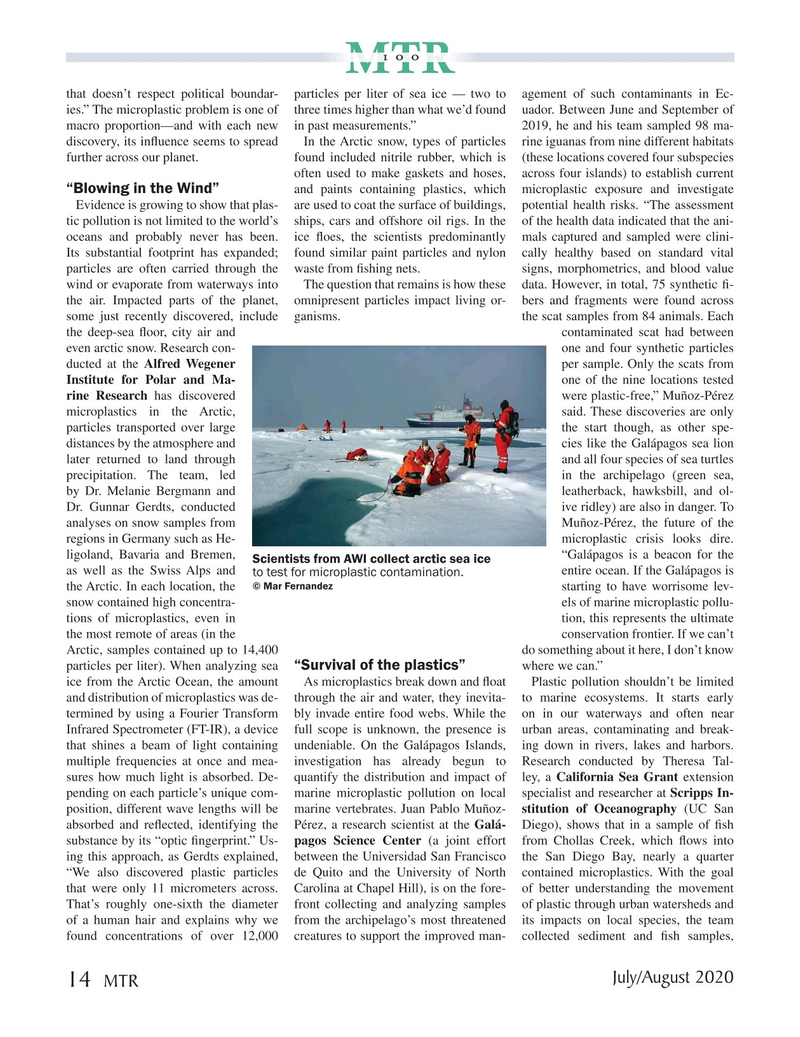
Page 14: of Marine Technology Magazine (July 2020)
Read this page in Pdf, Flash or Html5 edition of July 2020 Marine Technology Magazine
100
MTRMTR that doesn’t respect political boundar- particles per liter of sea ice — two to agement of such contaminants in Ec- ies.” The microplastic problem is one of three times higher than what we’d found uador. Between June and September of macro proportion—and with each new in past measurements.” 2019, he and his team sampled 98 ma- discovery, its in? uence seems to spread In the Arctic snow, types of particles rine iguanas from nine different habitats further across our planet. found included nitrile rubber, which is (these locations covered four subspecies often used to make gaskets and hoses, across four islands) to establish current “Blowing in the Wind” and paints containing plastics, which microplastic exposure and investigate
Evidence is growing to show that plas- are used to coat the surface of buildings, potential health risks. “The assessment tic pollution is not limited to the world’s ships, cars and offshore oil rigs. In the of the health data indicated that the ani- oceans and probably never has been. ice ? oes, the scientists predominantly mals captured and sampled were clini-
Its substantial footprint has expanded; found similar paint particles and nylon cally healthy based on standard vital particles are often carried through the waste from ? shing nets. signs, morphometrics, and blood value wind or evaporate from waterways into The question that remains is how these data. However, in total, 75 synthetic ? - the air. Impacted parts of the planet, omnipresent particles impact living or- bers and fragments were found across some just recently discovered, include ganisms. the scat samples from 84 animals. Each the deep-sea ? oor, city air and contaminated scat had between even arctic snow. Research con- one and four synthetic particles ducted at the Alfred Wegener per sample. Only the scats from
Institute for Polar and Ma- one of the nine locations tested rine Research has discovered were plastic-free,” Muñoz-Pérez microplastics in the Arctic, said. These discoveries are only particles transported over large the start though, as other spe- distances by the atmosphere and cies like the Galápagos sea lion later returned to land through and all four species of sea turtles precipitation. The team, led in the archipelago (green sea, by Dr. Melanie Bergmann and leatherback, hawksbill, and ol-
Dr. Gunnar Gerdts, conducted ive ridley) are also in danger. To analyses on snow samples from Muñoz-Pérez, the future of the regions in Germany such as He- microplastic crisis looks dire. ligoland, Bavaria and Bremen, Scientists from AWI collect arctic sea ice “Galápagos is a beacon for the as well as the Swiss Alps and to test for microplastic contamination. entire ocean. If the Galápagos is © Mar Fernandez the Arctic. In each location, the starting to have worrisome lev- snow contained high concentra- els of marine microplastic pollu- tions of microplastics, even in tion, this represents the ultimate the most remote of areas (in the conservation frontier. If we can’t
Arctic, samples contained up to 14,400 do something about it here, I don’t know particles per liter). When analyzing sea where we can.”“Survival of the plastics” ice from the Arctic Ocean, the amount As microplastics break down and ? oat Plastic pollution shouldn’t be limited and distribution of microplastics was de- through the air and water, they inevita- to marine ecosystems. It starts early termined by using a Fourier Transform bly invade entire food webs. While the on in our waterways and often near
Infrared Spectrometer (FT-IR), a device full scope is unknown, the presence is urban areas, contaminating and break- that shines a beam of light containing undeniable. On the Galápagos Islands, ing down in rivers, lakes and harbors. multiple frequencies at once and mea- investigation has already begun to Research conducted by Theresa Tal- sures how much light is absorbed. De- quantify the distribution and impact of ley, a California Sea Grant extension pending on each particle’s unique com- marine microplastic pollution on local specialist and researcher at Scripps In- position, different wave lengths will be marine vertebrates. Juan Pablo Muñoz- stitution of Oceanography (UC San absorbed and re? ected, identifying the Pérez, a research scientist at the Galá- Diego), shows that in a sample of ? sh substance by its “optic ? ngerprint.” Us- pagos Science Center (a joint effort from Chollas Creek, which ? ows into ing this approach, as Gerdts explained, between the Universidad San Francisco the San Diego Bay, nearly a quarter “We also discovered plastic particles de Quito and the University of North contained microplastics. With the goal that were only 11 micrometers across. Carolina at Chapel Hill), is on the fore- of better understanding the movement
That’s roughly one-sixth the diameter front collecting and analyzing samples of plastic through urban watersheds and of a human hair and explains why we from the archipelago’s most threatened its impacts on local species, the team found concentrations of over 12,000 creatures to support the improved man- collected sediment and ? sh samples,
July/August 2020 14
MTR
MTR #6 (1-17).indd 14 8/13/2020 8:40:24 AM

 13
13

 15
15
